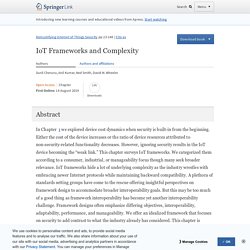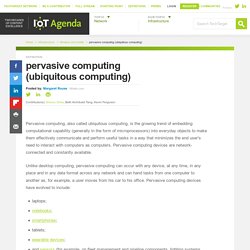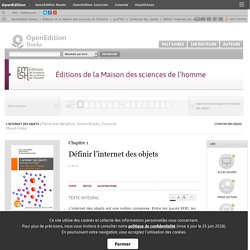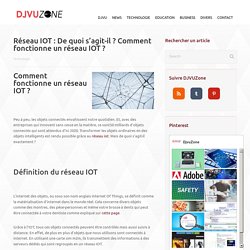

IoT Frameworks and Complexity. In this section, we explore several IoT framework architectures highlighting similarities and differences.

In some cases, differences exist because different frameworks intend to address different requirements and use cases. In other cases, significant overlap of features and capabilities appears to exist because they address similar requirements but do so differently. This is unfortunate because it creates opportunities for incompatibilities. Such differences may be benign when used in isolated deployments but add significant complexity when interoperability across multiple deployments is desired. Open Connectivity Foundation (OCF) The Open Connectivity Foundation (OCF) was originally formed under the name Open Interconnect Consortium (OIC).
The OCF framework (Figure 2-8) consists of three layers, Transports, Core Framework, and Profiles. The transport interface interaction model roughly follows an object lifecycle pattern called CRUDN – Create, Retrieve, Update, Delete, and Notify. TheseLEMOINE. Ubiquitous Computing Examples in 2020 [Updated] - Darwin Recruitment.
Today, you're going to learn about some ubiquitous computing examples from around the world.
![Ubiquitous Computing Examples in 2020 [Updated] - Darwin Recruitment](http://cdn.pearltrees.com/s/pic/th/ubiquitous-recruitment-219761138)
You might not know it yet, but ubiquitous computing truly is everywhere. From smartwatches to self-driving vehicles and everything in between, so much of modern life is part of a ubiquitous computing-oriented way of thinking – but it’s the sort of phenomenon that often only the experts know about in detail. Which is where I step in.
Searches for ubiquitous computing have steadily declined since 2014: Which seems strange, as the amount of ubiquitous computing devices available to us seems to have increased. You can also find out how businesses can use ubiquitous computing in this other article. This article is intended as a guide to all things ubiquitous computing and is designed for those who want to learn more about how it works. I will finish by thinking about what the future of ubiquitous computing might look like. What is Ubiquitous Computing (Pervasive Computing)? Pervasive computing, also called ubiquitous computing, is the growing trend of embedding computational capability (generally in the form of microprocessors) into everyday objects to make them effectively communicate and perform useful tasks in a way that minimizes the end user's need to interact with computers as computers.

Pervasive computing devices are network-connected and constantly available. Unlike desktop computing, pervasive computing can occur with any device, at any time, in any place and in any data format across any network and can hand tasks from one computer to another as, for example, a user moves from his car to his office. Pervasive computing devices have evolved to include: Often considered the successor to mobile computing, ubiquitous computing generally involves wireless communication and networking technologies, mobile devices, embedded systems, wearable computers, radio frequency ID (RFID) tags, middleware and software agents. What is the Internet of Things, and how does it work? There’s a lot of noise at the moment about the Internet of Things (or IoT) and its impact on everything from the way we travel and do our shopping to the way manufacturers keep track of inventory.

But what is the Internet of Things? How does it work? And is it really that important? What is the Internet of Things? In a nutshell, the Internet of Things is the concept of connecting any device (so long as it has an on/off switch) to the Internet and to other connected devices. That includes an extraordinary number of objects of all shapes and sizes – from smart microwaves, which automatically cook your food for the right length of time, to self-driving cars, whose complex sensors detect objects in their path, to wearable fitness devices that measure your heart rate and the number of steps you’ve taken that day, then use that information to suggest exercise plans tailored to you.
How It Works: Internet of Things. FwThinking Ep1 Internet of Things 800k. 2011 Linternet des objets. L'internet des objets (IoT - Internet of Things) c’est quoi. L’Internet des objets - Définir l’internet des objets - Éditions de la Maison des sciences de l’homme. 1L’internet des objets est une notion complexe.

Entre les puces RFID, les solutions de nommage ou middlewares, l’internet des objets est composé de nombreux éléments complémentaires ayant chacun leurs propres spécificités. Pour mieux appréhender la notion, nous proposons de définir les grands principes de l’IdO tels qu’ils apparaissent aujourd’hui à la lecture des recherches et des rapports réalisés sur la question. Réseau IOT : De quoi s’agit-il ? Comment fonctionne un réseau IOT ? Peu à peu, les objets connectés envahissent notre quotidien.

Et, avec des entreprises qui innovent sans cesse en la matière, ce sont50 milliards d’objets connectés qui sont attendus d’ici 2020. Transformer les objets ordinaires en des objets intelligents est rendu possible grâce au réseau iot. Mais de quoi s’agit-il exactement ? Définition du réseau IOT L’internet des objets, ou sous son nom anglais Internet Of Things, se définit comme la matérialisation d’internet dans le monde réel. Grâce à l’IOT, tous ces objets connectés peuvent être contrôlés mais aussi suivis à distance. Le fonctionnement de ce réseau The Internet of things repose sur l’identification des objets afin d’en recueillir les données et que celles-ci soient envoyées sur une plateforme Cloud ou sur une application. De ce fait, pour fonctionner le réseau IOT a besoin de la technologie M2M (machine to machine).
Un objet connecté a donc besoin d’une carte sim m2m. Qu’est-ce que l’IoT et pourquoi mener une stratégie d’IoT ?